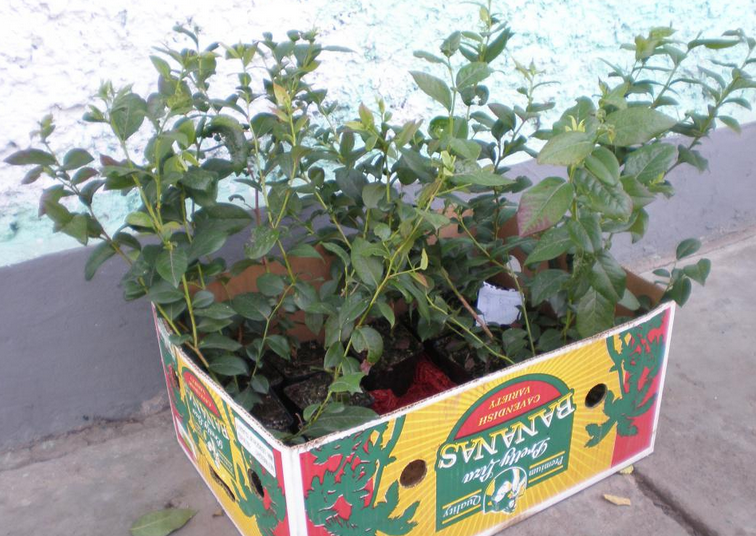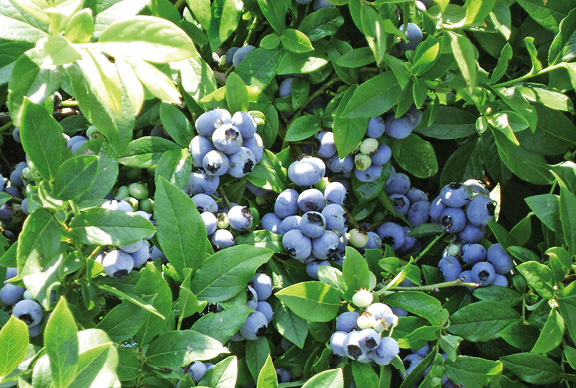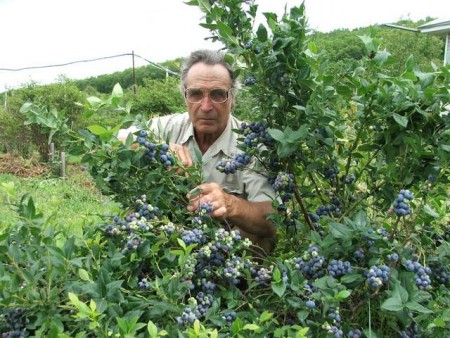Secrets of growing tall blueberries in the garden
Content
Soil and planting
If you want the berry bushes to bear fruit perfectly and feel comfortable on the site, you must first take care of the planting site. Although in nature, tall blueberries are a marsh berry, the selectively bred and “domesticated” berry does not like the soil in which surface water stagnates. Therefore, if a similar phenomenon is observed on your site, drainage should be organized. On clay soils, if the groundwater is close to the surface, it is better to plant the bushes on a small hill - a hill.
A landing site should be chosen that is protected from cold winds, but open to sunlight. The more the berry receives the sun, the sweeter and tastier it will be, and the seedlings will grow healthy.
Sandy soil and peat bogs are favorable for planting bushes. Not everyone can boast of a similar soil composition in the garden, but do not despair.  The soil where tall blueberries will grow can be improved:
The soil where tall blueberries will grow can be improved:
- If there is loamy soil on the site, the planting hole should be filled with a mixture of sand and peat, taken in proportions of 1: 3.
- If you have a peat bog, but sour - dilute the soil with sand, 2-3 buckets per square meter will be enough.
- It is recommended to enrich depleted soils with fertilization. You will need phosphorus, nitrogen and potassium, taken in equal proportions. After enrichment with fertilizers, the soil must be carefully dug up.
- If you have previously introduced humus into the soil, then you should not give up fertilizers, only the proportions of their introduction will be different - 3 parts of potassium, 2 parts of phosphorus, 1 part of nitrogen. Everything is carefully dug up.
Bushes are planted in the spring before the buds swell or in the fall. The best planting material is 2 year old seedlings, they do not need any pruning before planting. The container in which the seedlings were delivered to you should be immersed in water for a sufficient time before planting so that the roots are saturated with moisture. This is usually about 15 minutes. If there was not enough soil, and the roots were very tangled, they should be carefully straightened. Try to save all the soil that crumbles from the roots and place it in the planting hole - there are mushrooms important for the development of the plant.
Landing holes should be dug with a depth of about 40-50 cm and a diameter of about 1 meter. If you are planting several bushes, then stick to a distance of 1.3-1.5 meters between them so that tall blueberries can grow and feel comfortable on the site. The following principle applies here: the later ripening variety, the greater the distance between the bushes. Early maturing varieties can do with a distance of 1 meter from each other.
We fill the planting hole for blueberries with the following composition: ½ - mix your land with high peat and add 5-10% of pine bark. Some recommend filling the hole with a mixture of only peat (2/3) and last year's coniferous sawdust (1/3). Both methods are correct. The pit is not completely filled, 5-8 cm should not be enough to the edge. We plant the blueberries in the center of the pit.  Try not to trample the ground too much. The bush goes 3 cm deeper into the ground above a lump of earth from a seedling.The remaining 5-8 cm are filled with mulch - fresh needles sawdust. So you will create ideal conditions for growing tall garden varieties of berries, and the weeds on the mulch will not be at ease, and you will not have to weed the bushes. In addition, mulching seedlings contributes to:
Try not to trample the ground too much. The bush goes 3 cm deeper into the ground above a lump of earth from a seedling.The remaining 5-8 cm are filled with mulch - fresh needles sawdust. So you will create ideal conditions for growing tall garden varieties of berries, and the weeds on the mulch will not be at ease, and you will not have to weed the bushes. In addition, mulching seedlings contributes to:
- Longer retention of moisture in the ground
- Protect plants from temperature extremes day and night, as well as in winter
- Faster development of shoots and their growth
- Healthy shrub development, because pathogens will not be able to get into the soil to the roots
- The decomposed sawdust becomes an additional fertilizer for the plant.
Blueberry care
Caring for tall bushes can be divided into 3 important stages: fertilization, watering, pruning.To get an excellent harvest from each bush, tall blueberries require good nutrition. She only needs fertilizers based on minerals. No organic matter in the form of manure, humus, compost and more! Only nitrogen, phosphorus, magnesium and potassium. For this, you can use ammonium sulfate, potassium sulfate, magnesium sulfate, zinc sulfate and superphosphate.  50-60 g of superphosphate, 15-35 g of magnesium and 1-2 g of a mixture of trace elements can ensure the normal development of the plant, this is the norm for one bush. Potassium sulfate will be enough 35-40 g per bush. Superphosphate is poured into the ground to a depth of about 10 cm. Nitrogen fertilizers are not applied immediately, but in 3 doses: 40% - when the buds bloom, 35% - in May, 25% - in early June.
50-60 g of superphosphate, 15-35 g of magnesium and 1-2 g of a mixture of trace elements can ensure the normal development of the plant, this is the norm for one bush. Potassium sulfate will be enough 35-40 g per bush. Superphosphate is poured into the ground to a depth of about 10 cm. Nitrogen fertilizers are not applied immediately, but in 3 doses: 40% - when the buds bloom, 35% - in May, 25% - in early June.
It is recommended to water blueberries with acidified water: 1 teaspoon of citric acid in a bucket of water or dilute table vinegar to a concentration of 0.2%. If you put sawdust under the bush, then acidifying the water is not necessary. Blueberries love moisture, it is especially important in August during the ripening of the fruits, just try not to overdo it so as not to cause rotting of the roots from excessive moisture.
Pruning of tall blueberries is done in early spring or fall when the leaves have fallen off. Only bushes that have reached 6-7 years of age rejuvenate. Leave at least 5 annual shoots. If the bush has grown a lot, try to thin it out. There are blueberry varieties that have taller shoots, so they are pruned more to stimulate their further growth.Loosening the soil around the bush can be done, but try to do it especially carefully so as not to damage the roots.
Typical mistakes
When growing tall blueberries, gardeners often complain about poor plant productivity or their rapid death. This means only one thing - somewhere they made a critical mistake.  Here are the most common ones:
Here are the most common ones:
- Knowing that forest blueberries grow in a swamp, gardeners try to create similar conditions for it - shade and moisture. The plant will survive, but you will not get the harvest from it.
- The acidity of the soil is not tested. Blueberries need 4-5 pH units.
- Bushes are planted exclusively in peat. Peat freezes strongly in winter, in spring it thaws later, the growth of shoots slows down, and they do not have time to be covered with bark by winter, so they die.
- On clay plots, gardeners forget to arrange drainage, the root system of the bushes does not receive enough air, but it has an excess of moisture, so it gradually dies off, leading to the death of the bush.
- It may happen that blueberries have taken root, but grows poorly. At the same time, its leaves are light green in color. There may be 2 reasons: lack of nitrogen and overestimated soil acidity.
Popular varieties
The tall blueberry bush got a similar name because it can reach a height of 3 meters. This is a very long-term plant. The berries are large - up to 2 cm in diameter. With good care, you can achieve a harvest of 5-9 kg per bush.
The most popular blueberry varieties:
- River. Early variety. The bush reaches a height of 2 m, the berries ripen at the end of July. It gives a lot of fruits - 8-10 kg. Ripe berries do not fall off the bush, they tolerate transportation well.
- Bluegold allows you to enjoy the fresh berry already in mid-July. This tall blueberry variety does not grow too high - a maximum of 1.5 meters. Productivity - 4.5-7kg. The bush looks very compact and decorative.
- The Puri variety will begin to give maximum yields only after 3 years - 5-7 kg each. The berries are very large - up to 2 cm in diameter, ripen at the end of July.
- Another variety with large berries is Duke. It has good frost resistance, both during flowering and during wintering. When planting, get 6-8 kg per bush.
- The Patriot variety will give you 5-7 kg of amazingly tasty berries every year. Plus, it looks very decorative.
- You can taste Toro berries at the beginning of August, it gives regular high yields.
- The Bluecrop variety is one of the most abundant in berries - 6-9 kg of large fruits. Very strong, tasty and beautifully colored. The most widespread variety in Europe.
- The Chippewa variety can withstand 38 degrees of frost, it is self-pollinated, and can even be grown in containers.
- Spartan ripens in late summer. He will give you 5-6 kg of berries, they have a special aroma and pleasant taste with sourness.
- Berkeley has a branched structure, can easily fit as a hedge. Productivity - 4-8 kg. Very strong peel of berries, well stored, transported. Ripens in mid-August. Very unpretentious. Resistant to fluctuations in temperature and humidity.
Video "Growing blueberries on our site"
The recording shows the technology of planting and caring for tall blueberries. By watching the video, you will learn the features of planting container plants in the ground, as well as how to increase fruiting.

